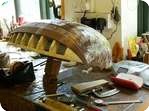David Van Edwards, UK 
|
About: The European lute derives both in name and form from the Arab instrument known as al ‘Ud, which means literally ‘the wood’ (either because it had a soundboard of wood as distinct from a parchment skin stretched over the body, or because the body itself was built up from wooden strips rather than made from a hollow gourd). The Arab ‘Ud was introduced into Europe by the Moors during their conquest and occupation of Spain (711-1492). Pictorial evidence shows Moorish ‘Ud players, and 9th and 10th century accounts tell of visits of famous players such as Ziryab to the court of the Andalusian emir ‘Abd al Rahman II (822-52). This ivory box dates from 968 the reign of al-Mugira the son of Abd al Rahman III in Andalusia and shows one of the earliest representations of an ‘Ud. It is being played standing up and in the detail you can see that the player is using a substantial plectrum. The figures are also wearing their hair in a style apparently also introduced by Zyriab, who seems to have been something of an arbiter of taste in Andalusia. He even founded a music school in Cordoba. Contact: David Van Edwards, UK Terms & conditions: |




